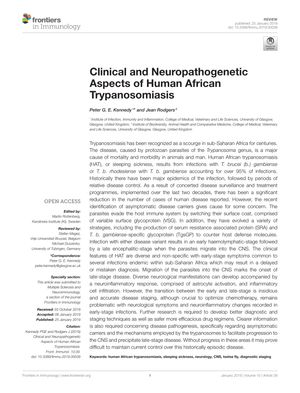Clinical and Neuropathogenetic Aspects of Human African Trypanosomiasis
January 2019
in “
Frontiers in Immunology
”

TLDR The document concludes that diagnosing and treating Human African Trypanosomiasis is challenging, but new treatments like fexinidazole are promising.
The document from 2019 reviews the clinical and neuropathogenetic aspects of Human African Trypanosomiasis (HAT), emphasizing the challenges in diagnosis, disease staging, and treatment. HAT, caused by Trypanosoma brucei gambiense and T. b. rhodesiense, progresses from an early haemolymphatic stage to a late encephalitic stage, with the latter involving severe neurological symptoms. The disease's diagnosis relies on direct visualization of parasites or serological methods, while staging depends on CSF examination. Treatment options are limited and toxic, with new drugs like oral fexinidazole showing promise. A study mentioned in the document found that fexinidazole successfully treated 91% of late-stage T. b. gambiense patients at 18 months, compared to a 98% success rate with NECT therapy. Despite progress, the WHO's goals to eliminate HAT face challenges such as resurgence, remote case detection, and potential drug resistance.